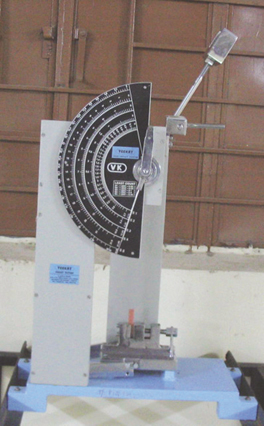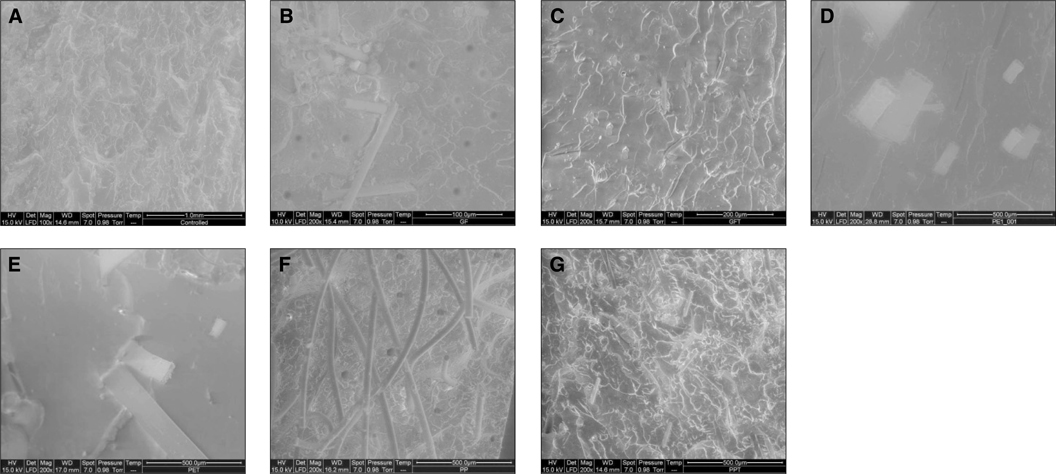J Adv Prosthodont.
2012 Feb;4(1):30-36. 10.4047/jap.2012.4.1.30.
Effect of fiber reinforcement on impact strength of heat polymerized polymethyl methacrylate denture base resin: in vitro study and SEM analysis
- Affiliations
-
- 1Department of Prosthodontics, VSPM's Dental College and Research Center, Nagpur, India. tusharmowade@gmail.com
- KMID: 2284781
- DOI: http://doi.org/10.4047/jap.2012.4.1.30
Abstract
- PURPOSE
The aim of this in-vitro investigation was to describe the effect of reinforcement with different fibers on impact strength of heat polymerized polymethyl methacrylate (PMMA) denture base resin and to analyze the effect of surface treatment of the fibers on the impact strength.
MATERIALS AND METHODS
The specimens were fabricated from the dies formed as per standard ASTM D4812. 2% by weight of glass, polyethylene and polypropylene fibers were incorporated in the PMMA resin. The Izod impact testing was performed on the unnotched specimens and the values obtained were analyzed using appropriate one way ANOVA, followed by unpaired t-test. Fractured ends of the samples were subjected to the SEM analysis.
RESULTS
The polypropylene fibers with plasma treatment showed the highest impact strength (9.229 x 10(2) J/m) followed by the plasma treated polyethylene fibers (9.096 x 10(2) J/m), untreated polypropylene fibers (8.697 x 10(2) J/m), untreated polyethylene fibers (7.580 x 10(2) J/m), silane treated glass fibers (6.448 x 10(2) J/m) and untreated glass fibers (5.764 x 10(2) J/m). Also the surface treatment of all the fibers has shown the significant improvement in impact strength. Findings of the SEM analysis justified the improvement in impact strength after surface treatment.
CONCLUSION
Reinforcement with the fiber is an effective method to increase the impact strength of PMMA denture base resin. The surface treatment of fibers further increases the impact strength significantly.
MeSH Terms
Figure
Reference
-
1. Johnston EP, Nicholls JI, Smith DE. Flexure fatigue of 10 commonly used denture base resins. J Prosthet Dent. 1981. 46:478–483.2. Ruffino AR. Effect of steel strengtheners on fracture resistance of the acrylic resin complete denture base. J Prosthet Dent. 1985. 54:75–78.3. Vallittu PK, Lassila VP. Effect of metal strengthener's surface roughness on fracture resistance of acrylic denture base material. J Oral Rehabil. 1992. 19:385–391.4. Smith DC. Recent developments and prospects in dental polymers. J Prosthet Dent. 1962. 12:1066–1078.5. Gutteridge DL. The effect of including ultra-high-modulus polyethylene fibre on the impact strength of acrylic resin. Br Dent J. 1988. 164:177–180.6. Solnit GS. The effect of methyl methacrylate reinforcement with silane-treated and untreated glass fibers. J Prosthet Dent. 1991. 66:310–314.7. Vallittu PK. Glass fiber reinforcement in repaired acrylic resin removable dentures: preliminary results of a clinical study. Quintessence Int. 1997. 28:39–44.8. Berrong JM, Weed RM, Young JM. Fracture resistance of Kevlar-reinforced poly(methyl methacrylate) resin: a preliminary study. Int J Prosthodont. 1990. 3:391–395.9. Goldberg AJ, Burstone CJ. The use of continuous fiber reinforcement in dentistry. Dent Mater. 1992. 8:197–202.10. Vallittu PK, Lassila VP, Lappalainen R. Acrylic resin-fiber composite-Part I: The effect of fiber concentration on fracture resistance. J Prosthet Dent. 1994. 71:607–612.11. DeBoer J, Vermilyea SG, Brady RE. The effect of carbon fiber orientation on the fatigue resistance and bending properties of two denture resins. J Prosthet Dent. 1984. 51:119–121.12. Vallittu PK, Vojtkova H, Lassila VP. Impact strength of denture polymethyl methacrylate reinforced with continuous glass fibers or metal wire. Acta Odontol Scand. 1995. 53:392–396.13. Matthews E, Smith DC. Nylon as a denture base material. Br Dent J. 1955. 98:231–237.14. Gutteridge DL. Reinforcement of poly (methyl methacrylate) with ultra high modulus polyethylene fibers. J Dent. 1992. 20:50–54.15. Ladizesky NH, Pang MK, Chow TW, Ward IM. Acrylic resins reinforced with woven highly drawn linear polyethylene fibres. 3. Mechanical properties and further aspects of denture construction. Aust Dent J. 1993. 38:28–38.16. ASTM international. Designation: D 4812-99, Standard test method for un-notched cantilever beam impact resistance of plastics (test method under jurisdiction of ASTM committee on plastics D-20). Annual Book of ASTM Standard. 1999. 03. 14:02.17. Anusavice KJ Philips' science of dental materials. 2003. 11th ed. St. Louis: Elsevier;733–734.18. John J, Gangadhar SA, Shah I. Flexural strength of heat-polymerized polymethyl methacrylate denture resin reinforced with glass, aramid, or nylon fibers. J Prosthet Dent. 2001. 86:424–427.19. Ladizesky NH, Chow TW. The effect of interface adhesion, water immersion and anatomical notches on the mechanical properties of denture base resins reinforced with continuous high performance polyethylene fibres. Aust Dent J. 1992. 37:277–289.20. Paula E Silva E, Rosa EL, Barbosa SV. Tissue reactions of polypropylene mesh used in maxillofacial trauma. Braz Dent J. 2001. 12(2):121–125.21. Braden M, Davy KW, Parker S, Ladizesky NH, Ward IM. Denture base poly(methyl methacrylate) reinforced with ultrathin modulus polyethylene fibers. Br Dent J. 1988. 164:109–113.22. Ladizesky NH, Cheng YY, Chow TW, Ward IM. Acrylic resin reinforced with chopped high performance polyethylene fiber--properties and denture construction. Dent Mater. 1993. 9:128–135.23. Smith DC. The non-metallic denture base-recent developments. Dent Pract. 1957. 8:73–80.24. Vallittu PK, Narva K. Impact strength of a modified continuous glass fiber-poly(methyl methacrylate). Int J Prosthodont. 1997. 10:142–148.25. Uzun G, Hersek N, Tinçer T. Effect of five woven fiber reinforcements on the impact and transverse strength of a denture base resin. J Prosthet Dent. 1999. 81:616–620.26. Kim SH, Watts DC. The effect of reinforcement with woven E-glass fibers on the impact strength of complete dentures fabricated with high-impact acrylic resin. J Prosthet Dent. 2004. 91:274–280.27. Karacaer O, Polat TN, Tezvergil A, Lassila LV, Vallittu PK. The effect of length and concentration of glass fibers on the mechanical properties of an injection- and a compression-molded denture base polymer. J Prosthet Dent. 2003. 90:385–393.28. Vallittu PK. Comparison of two different silane compounds used for improving adhesion between fibres and acrylic denture base material. J Oral Rehabil. 1993. 20:533–539.29. Clarke DA, Ladizesky NH, Chow TW. Acrylic resins reinforced with highly drawn linear polyethylene woven fibres. 1. Construction of upper denture bases. Aust Dent J. 1992. 37:394–399.30. Ramos V Jr, Runyan DA, Christensen LC. The effect of plasma-treated polyethylene fiber on the fracture strength of polymethyl methacrylate. J Prosthet Dent. 1996. 76:94–96.
- Full Text Links
- Actions
-
Cited
- CITED
-
- Close
- Share
- Similar articles
-
- EFFECTS OF CHOPPED GLASS FIBER ON THE STRENGTH OF HEAT-CURED PMMA RESIN
- The Effects Of Thermocycling On The Bond Strength Between Cobalt-Chromium Alloy And Denture Base Resin
- Strength of glass fiber reinforced PMMA resin and surface roughness change after abrasion test
- A comparison study on shear bond strength of 3D printed resin and conventional heat-cured denture base resin to denture relining materials
- Adherence Of Oral Bacteria On Chitosan: Added Denture Base Materials In Vitro




